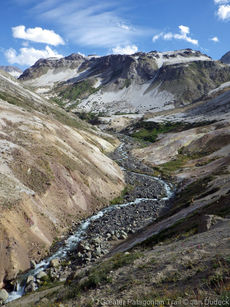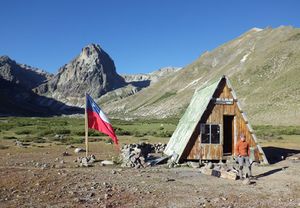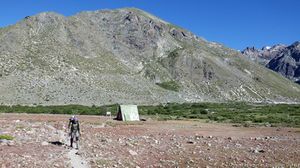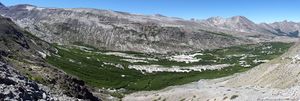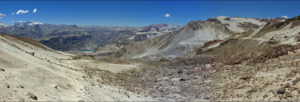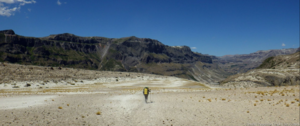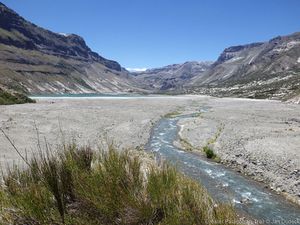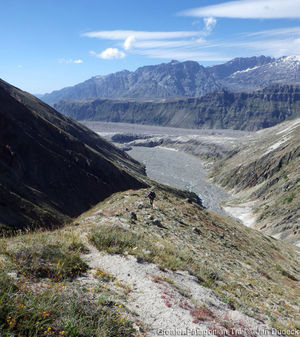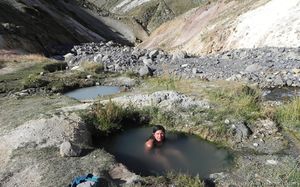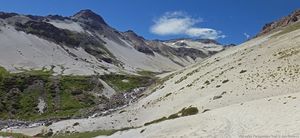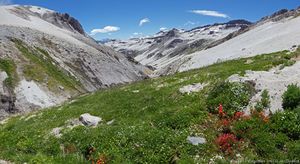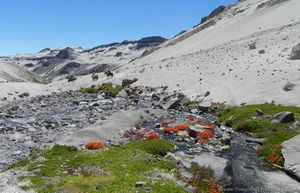GPT06 - Volcán Descabezado
|
|
|
| |||||||||||||||||||||||||||||||||||||||||||||||||||||
| All GPT sections (click to show) |
|---|
|
GPT Section Articles
|
Season Section Log, Recent Alerts and Suggestions
Drinking the water of the hot springs is not recommended because it can upset your stomach. Better take fresh water from the river or a cold spring nearby. When climbing the Descabezado Grande take plenty of water from the base camp in particular if you plan to spend one night higher up. You may refill your supplies with snow near the summit.
REPORT
5 days, 75 miles, 15K ft ascent, Dec. 31-Jan 3, 2023 David and Erika SOBO Get to TH Parque ingle before 1:00 pm, otherwise they close it for entrance. We did get internet and got the correct CONAF ticket -the one heading to El Bolsón. Once you get out of the park and into the Cuesta Las Anima, the wild parts begin. Hope you got your dirty girl gaiters; cause you’re going to need them. Sand city. Gaiters worked great. Remote and desolately beautiful. Water up at the end of Laguna del Caracol, at the river that comes out of the ground, you have a dry climb ahead. Walk out was straightforward. Got a lift from ENEL employee.
- 2022-Dec-28-29 / SOBO / RR / Tomáš
I connected in Thermas Azufre from GPT 05. I recommend it as a camping spot. I have seen the tracks of people staying on the western side of the valley but I think it is better to ford, there is anoce trail there on the eastern side. There is a place with and island where I needed to remove my shoes just for about three meters (the stream was not strong enough for me to keep the shoes on).
I took a detour to the lake at the pass - nice. No snow anymore. Reached the Refugio Blanquillo (which is a puesto, an arriero had two dogs and a thousand shep there), met a group of tourists oj horses and two Chilean hikers there, so crowded all of a sudden. The pool there is indeed lukewarm. The water from the stream is said not to be good - I filtered it (for the first time on GPT) and was fine. But if not climbing the volcano, I would recommend to camp 2 km further at the next water source. I no longer carry water with me and just drink a lot when I find a source, there is a lot of them, even in the semidesert (the sand is actually white pumice from the volcanoes). It is quite dusty, my hands got dry and that normally does not happen to me. I agree with the recommendation to apply sunscreen at least three times a day!
The second day I walked all the way to the main road. Stthe pass, there is still a bit of snow but white manageable. Going down from the lake, ghere is no water until around half or one third of the minor road in the valley, beware. Walking-wise, this was the easiest section on GPT for me. At the mainroad, the camping at the shop after the bridge was closed. I hitched somebody in he truck who knew the owners, called them and they came to open it for me. 5000 pesos but I gave the lady 10000 as she had to drive here tonopen the aging for me. There is electricity and cold shower and shadow. Almost nothing at the shop. The bus is said to leave at seven. I slept and now will try hitchhiking.
- 20. - 24. Dec 2022 / Will / SOBO, Parque Inglés - Los Cipreses
Amazing trail! It's quite desolate but the landscape varies enough to always keep things interesting. Trudging up the sandy hills could be demoralizing, but getting to run down the other side more than made up for it. Water was still plentiful though not much snow was left, I only had to cross a few small patches. Thankfully heat wasn't a problem at all for me, I even felt cold a few times with the altitude and wind.
Caught the 5pm bus from Molina to Radal for 3000 pesos, then a van came by a few minutes later to take us to parque inglés for another 3000. Was nice to meet a bunch of Chilean hikers, who were all going to El Bolson and back. We camped at the Rocas Basílicas campsite right at parque inglés, 7000 pesos next to a beautiful river.
I had phone signal at parque inglés, so I bought the pass online for 8 USD. There was no one at the Conaf office at 7 30 the next morning, so I just hopped the gate and walked through.
I ran into a few arrieros relaxing at the Azufre hot springs, the only people I saw along the trail. They were friendly but it was tough to understand their heavy Chilean Spanish. They said I could camp with them but there wasn't a ton of room so I walked on.
There were some geysers shooting up from the muddy riverbank near the gpx track so I took a wider route around. An arriero also told me to take a trail higher up along the dunes so I followed that to the ford. The ford looked tough so I kept walking 2ish km along the other side until I could easily hop across. But it was slow going, probably not worth it.
I ended up having to camp on a random sand dune. I had some trouble getting my tent to stay up tied to rocks, since I couldn't get stakes in. I'd definitely recommend using tieouts you can really secure to rocks, or even a freestanding tent.
The rest of the hike went smoothly. I easily made it to los cipreses in three days of hiking from parque inglés. The guard was super friendly, inviting me in and giving me a bunch of water. I camped across the street from the shop near the bus stop, ask at the shop if you want to camp there. The guy running the camping was also super nice, he messaged the bus driver and told me it would be at 9 or 9 30 the next morning, because it was a Saturday (it was also Christmas eve). The bus ended up showing up at 9 45, and costed 3200 pesos to Talca.
The side trip up Volcan Los Hornitos was very worth it, there's a fairly gradual trail up and you can just sprint straight down. I didn't even need to bring any water (just some gummy bears).
I got by without gaiters, but bring them if you can. I should have used more sunscreen, the reflection off the sand is strong.
Martin
Joining section 6 directly from the previous one with a little challenging connection trail (see our comment from section 5), we continued to the Hot Spring del Azufre. On the way there is one steep traverse. We used hot spring to cook our rice which really saved us as we run out of gas. The landscape on the whole section is amazing, we really enjoyed it! Ascent to the pass is nice and gradual, hiking in the sand is a little slower, but the opposite when going down. We camped at the El Estadio, almost no wind that day, great place to sleep . In the morning we continued on a nice and easy trail, great views around the volcanos… short break by the laguna thats great for swimming. We camped a little before the camp marked in the gps, there is one place, probably used by arrieros, with a fireplace and a few rocks around it. Being out of the gas we set a fire using wood that was already in there and some others we gather during the day. The view to the volcanos must be one of the best we have seen here so far! The next day we continued to the last Hornitos pass and through the valley, again really nice hiking on a clear trail. Last few kms on the road and since we missed the only bus to Talca that is leaving early in the morning (7:00) and did not have luck with hitchhiking, we stayed in a camp right next to the road. Its just a few meters before it, in the same direction we came from. On the left side is a house with some old advertisment sign (coca-cola or similir) on its fence, and the lady there has a small shop. The camp is on the other side - cold shower, toilets, electricity and access to the river, all for 5000 for 2 people. We even got sandwiches for dinner as there was no other place around to eat. Overall, when combining both sections we recommend to plan carefully, but its definitely worth the effort, especially this section 6.
- 14. - 16. Dec 2022 / Anna&Christopher / SOBO, Parque Inglés - Los Cipreses
The section is pretty tough, but beautiful with a quite unique landscape. We definetly would do it again.
Recomendations: bring lots of suncreme, a good hat, gaiters.
How to get there: We took a bus from Santiago (terminal at the metro station Universidad de Santiago) to Curico. Across the street from the bus terminal in Curico leaves a blue bus to Molina for 1k CLP. From Molina we hitchhiked to Parque Inglés. You have to be there before 3 pm to be allowed to hike up to El Bolson. To camp they charge 8k CLP p.p and the park entry is also 8k CLP p.p.
The first day we started early from El Bolson. From midday on it was super tough due to the white sand which makes walking really tiring and reflects the sun which makes it super hot without shade. The next day was pretty similar. The whole section there was plenty of water. There was no much snow left at the passes, so we had no trouble without spikes. On the last day, after arriving to the dirtroad (8 km from los Cipreses), we got offered a ride after a while and the guy brought us directly to El Médano. The shop there has pasta, rice, bread, tomato salsa, mayo, chips, biscuits/chocolate and suncreme (but quite pricey). In El Médano we camped for 6k CLP p.p.
- 3 to 6 of December 2022 / Véronica / GTP06 RR SOBO / 3.5 days
Route: Parque Inglés - Laguna Ánimas - Termas del Azufre - Termas del Blanquillo - Laguna del Caracol - Laguna de los Hornos - Los Cipreses
A beautiful, remote section of true mountain wilderness. It took me 4 days, but only 2 hours hiking the dirt road to Los Cipreses on the last day (so very doable in 3 days). The only people I saw were a couple of arrieros at Termas del Blanquillo who told me they hadn't had a winter as snowy as this one in over 10 years. I was glad to have my microspikes for the vast snow fields near/on the passes. A couple places would have felt quite unsafe without them.
Notable tidbits:
Took a bus from Molina at 5pm (on a Friday) to El Radal, then hitchhiked to Parque Inglés. I camped there the first night for 7000 pesos. Pricey, but at least I had a beautiful and secluded spot by Rio Claro.
The stretch between Las Ánimas Pass and Termas de Azufre had some sketchy traverses across disintegrating scree slopes that were downright nerve-wracking. I suppose if you go down to Laguna Mondaca, then back up to the Termas, you may not encounter this hazard. But I did get to observe a condor soar above my head on thermals for an hour as he surveilled his domain, that was super cool.
For the first ford after Termas de Azufre, I crossed further upstream than indicated on the GPS track (see Carlos's comment below). It looked a lot safer there than downstream. There's continuous snow for about 3 km going over the pass after Thermas de Azufre, best to cross in the morning to avoid postholing when the snow gets too soft.
Los Hornitos pass has a large, very steep lip of snow (leftover cornice) on its south side. It's possible to go around it by heading north for 50-100 meters and then making your way down on the volcanic sand.
The spring between Termas del Blanquillo and Laguna del Caracol is a beautiful little desert oasis in an orherwise hot and dry stretch. It was a splendid spot to camp.
There is LOTS of water. Laguna del Caracol and Laguna de los Hornos are both full of clear, refreshing water. A lot of the "water" GPS waypoints are actually fords this time of year (easy ones), and there's a lot of other water sources not listed on the tracks. But the section is very exposed, no shade, and very hot in the midday sun unless a breeze is blowing.
No issues with the guards at Los Cipreses, they were friendly and let me pass no problem. From the first bus stop on the road, I hitched easily to Talca to resupply.
- 20 Feb 2022 / Molly / RR southbound, 4 days
Amazing section! I found the landscape to be very varied despite the lack of vegetation - and even with many pretty flowers near the streams. I personally found it to be a great ending to my GPT journey, a big contrast to the landscapes further south. Would make for a tough start though. Plenty of water. Met one hiker doing Circuito el Cóndor and three Chilean tourists on horseback. No arrieros, but plenty of cows and horses. The weather was cold and windy, sometimes veritable sandstorms which meant I almost couldn't open my eyes - maybe sunglasses could have helped. I wore my long pants over my boots instead of gaiters - should have listened to the advice, so much sand!
Signs on the way to parque inglés say that you can only buy tickets online - don't know how strict they are, but no cell phone coverage at parque inglés and long before in case they insist. You have to be there before 15 to be let through to El Bolsón. Easy 11 km to El Bolsón through a young forest. No water at the first "ford" waypoint. Campground has toilets and showers, it's the only place you're allowed to camp until after Valle del Indio. Nice enough place next to the impressive Colmillo del Diablo. In hot weather it might be nice to camp here to take the long ascent in the morning. Laguna de las Animas would be a good campsite plus a nice place to swim. The first "water" waypoint afterwards is also great for camping - there is a nice little meadow. Las Animas pass is gorgeous! After Termas Azufre there are many confusing paths. They mostly seem to lead to the same place, but keep an eye on the GPS. When descending from the 2700 m pass towards Termas Blanquillo, you don't have to cross the stream to your right even though many paths do it. As noted by others, the hot springs Baños del Blanquillo are luke warm - but fine if you want to wash yourself a little and the stream is too cold. The refuge is locked. The next camp waypoint is in a cute valley with many streams, bushes and flowers. No grass, though. Laguna Caracol is beautiful as well, but very bare, surrounded by sand. I really liked the campsite afterwards, with views of both Volcán Descabezado and Cerro Azul. From there, a small CC section to the ascent where the path picks up again towards the Hornitos pass. Even more gorgeous with great and very different views to each site. Volcán Hornitos and the other little craters look really funny and special. Some hail was coming in, though, so I quickly slided down to the next camp waypoint, again a nice flat meadow. No water on the ascent. The first streams at the top of the pass were dry, but the path crosses a stream in 2100 m altitude. If you fill up at the water waypoint before the pass I agree you wouldn't have to carry extra water, the time between these two water points is around 2-3 hours. I climbed to the rim of Volcán Hornitos, there's nothing in there, but if you walk to the highest point the view is nice enough. It took me 20 minutes in total, and it was about worth that. The gravel road is nice the first kilometres, but then it gets pretty boring. The security guard at the end was very nice and welcoming. I camped at the shop just before the road - nice place by the river, 3000 per person with toilets and a cold shower, or 50,000 for a cabaña. From there I hitched the 3 km down the road to Restaurant Cordillera, nice enough, great with a beer, meat and fries. Bus left from the bus shed at 7:20 next morning - think it depends whether it goes to El Médano or not
- 20 to 25th January 2022 / Carlos / GPT06 RR SOBO
Route: Parque Inglés - El Bolsón (Colmillo del Diablo summit) - Termas del Azufre - Termas del Blanquillo - Laguna Caracol - First bus stop on CH115 road.
I hiked this route only a couple of days after Verónica & Jo. Not much to add except:
First day just hiked to El Bolsón (easy 4 hours), pitched my tent on the gorgeous campsite, left the heavy load and climbed the imposing "Colmillo del Diablo" (easy hike on a trail that goes around the back of the mountain).
From Termas del Azufre climbing to the pass I followed a faint track on the steep loose slope instead of crossing at the first river ford. After a few hundred meters the track takes you to a flat wide rocky area (just before the slope becomes impossibly steep), where you can very easily ford the river (I didn't even get my feet wet).
Plenty of buses Molina - Parque Inglés. But only one bus from el Médano - Los Cipreses to Talca, at around 7 am, which returns at 15:00. Only week days. Basic camping just in front of Los Cipreses shop (only ice cream, drinks, choco bars, biscuits): $4.000 pp.
- 2022-01-10 to 2022-01-15 | Veronika & Jo | GPT06 (only) RR SOBO
Route: Parque Inglès -> Laguna de las Animas -> Termas de Azufre -> Descabezado base camp -> Laguna del Caracol -> Laguna Hornitos -> First bus stop on 115-CH
The five nights we just spent in a tent was the longest stretch we have ever gone without a decent bed on a hike. We skipped Radal, Laguna Mondaca and Termas de Medano, but still hiked in 6 days what others did in 3-4. We're basically easing into the GPT, gaining some fitness and experience before taking on the harder challenges.
As others have said: the views are otherworldly and stunning. We felt like Touaregs traveling from oasis to oasis in the Saharan desert. Except that there actually are plenty of springs and little rivers flowing in most valleys.
Useful tidbits:
- There really is no shade after El Bolsòn. Either you make your own (e.g., adapting your tent to not trap heat) or you dress like a Touareg (loose clothing fully blocking the sun). For us, this was the hardest to deal with. We got up early but often stopped hiking at 13:00, enjoying the lakes or even just sitting down doing nothing that takes energy.
- High-heeled boots and long trousers work well to keep the sand out.
- Confirming Shn0rhelez: going up from Termas de Azufre until the second ford indeed passes plenty of water, no need to carry any.
- Laguna Hornitos is drying up and hence less beautiful than the other lakes. Maybe it's better to camp at the start of the Hornitos plateau (SOBO, so north entry) as the area is flat and there is reasonably clean running water there.
- There is no bus to Talca from Los Cipreses on saturdays or sundays. We asked at the shop and got a ride to Colorado from the brother-in-law of the shopkeeper for 15000 CLP.
- In supermarkets, you can buy alcohol desnaturalizado cheaply in the nail polish section, or alternatively, use alcohol de quemar from the combustibles section.
- 26/12 2021 to 04/01 2022 Section 6 and 7 (option) Sobo 9 days
From Parque Inglés to the entrance of Reserva Achibueno Buy your ticket online for “El Bolsón” on the CONAF website and get to the trailhead before 3pm 4hrs hike to El Bolsón, a great place with waterfall, great views, nice camping spots, hikers TO CHECK: Bus from Molina to Parque Ingles leaves at 9 am (not positive) on week-ends and holidays Easy hitch from Radal to Parque Ingles coz lots of campers going there on week-ends Be careful a ranger told me the park closes on Mondays It took me around 4 days from Parque Siete Tazas Park entrance to the road Q115 (Central Cipreses) From Road 115 I hitched to a village by Colbún lake where I resupplied : good supermarkets (a little on the expensive side), food truck , pastry shop I didn't like Altos de Lircay NP : after El Bolson (4 hrs in) no fucking shade for 3 days and an half except that of a shelter a little off trail, blazing sun all day, sand sand sand, I found the place so inhospitable, monotonous sights : sand dunes for ever, quite some struggling pedalling in the soft sand, plus I had no gaiters (stupid me) and low heels shoes so that was a bummer. However the place is super special, feels like on the moon (beautiful pictures) and I can understand why many love it Some “hot springs” are actually just luke and others just a hole or boiling hot (I added these informations to the track and waypoints I sent to Jan Dudek) so don't be like me fantasizing all day on that fantastic bath you will get or wait for Jan's update (thanks so so much for all you do mate). After resupplying I hitched on option 7 XXX all the way the Mellado cañon (really nice, by the river all the time), communities. After hiking South from Carizales (which has a very limited “store”) I was short on time and food and realized bare landscapes over the tree line were not my cup of tea (I prefer hiking below 1700 m in this part of Patagonia) so I left RR and took another option all the way to the West to Reserva Achibueno which I really enjoyed : great landscapes, lakes, rivers and met some cool hikers and fishermen
- 12 Feb Frank RR Southbound
At the end of GPT06 if you go on the north bank of Rio Maule the route is blocked by a cliff beyond Los Alamos & you need to cross the river to continue. Better to go on the road. After 2KM on the road you pass 2 shops, better food selection than in El Medano. They have accommodation also. At Bridge 17 you can rejoin RR or continue on road but RR is nicer.
- 09 - 12 December 2021, SOBO, Vera & James
We arrived the day before at Parque Ingles and camped the night there. From Molina there is a bus to Radal at 5pm wed-fri, and direct to Parque Ingles on weekends. The only way to pay for park entry is online at www.aspticket.cl.
As an aside, we really liked Molina. It has plenty for resupply whilst being nice and small. There is a fishing shop opposite the Santa Isabel supermarket that sells gas.
Day 1 we headed up the RR as far as just above Laguna de las Animas by 2pm, a brutal climb in the midday sun! At this point the sun disappeared and clouds quickly rolled in, within 10 minutes lightning was hitting the peaks directly around us. We beat a hasty retreat back to El Bolsen and camped there.
We decided to take the alternate route past Laguna Manatial Pelado. A beautiful route if hot and sandy. We have realised the best time time to take on a long, sandy ascent in sunny weather is very early in the morning, after 9am it was brutally hot.
We then continued on the regular route. As has been said before, it's remote and stunning. We had some strong winds coming over Pass de Hornitos, and even some sleet on the final day!
Arrived in Los Cipreses on a Sunday and we didn't see a single person except the security guard. We got mixed messages from him and then the mini shop owner about buses to Talca. I would assume there isn't one on a Sunday. We hitched to El Colorado then got a bus from there to Talca.
- 2021 Dec: 03-09, SOBO, RR, Kris&Stiina
We also decided to combine sections 5 and 6 to avoid in’n’out to and from Parque Inglés. It took us 6 and a half days and some of it was bloody hard. I have never before experienced my ass being handed over to me by a trail. We got beaten to the point where first signs of weakness started to show and I have to admit we kind of even started discussing a plan B and bailing this ditch trail. But only for a moment, once you hit the rock bottom there is only one way to go - up! It was literally and figuratively, and as terrain improved so did our mood and we laughed off the silly thoughts we had had earlier.
The first 45km of the section 5 were great, awesome hiking and then shit hit the fan real quick. Ascent up from the ford at km 45 was hard but alright. And then came the descent down to Rio Negro (51km), very steep and very loose scree slope. We wanted to make it to Rio Colorado for the night to cross it early in the morning in case there is no bridge. But because the trail or I must rather say the lack of it was really taking more time than we expected, by the time we got to Rio Negro it was already getting dark. The river was very rapid and murky so you couldn’t gauge the depth of it and couldn’t see where to step, we had to really concentrate to cross it, luckily it was only balls deep.
It was dark as we got across it and we continued the fun, albeit type 2 fun, illuminated by our headlamps. Then came the insanely steep gully that allowed you to enter the valley of Rio Colorado. Something was off with the elevation lines on Gaia and it showed that we will be descending right over the cliff, it was luckily only a glitch. As we couldn’t see much ahead we kept descending ever so carefully on this very very challenging terrain, I would even go as far as to say that it was stupid and outright dangerous. But there was no other way, you just had to stay focused. There were also some rocks falling off the cliff under which we were descending. In a sense night was a good time to do it because you couldn’t see all the dangers - only what lie within the beam of the headlamp.
Then came an extremely slow going, pretty much crawling speed traverse down to Rio Colorado, which we fully improvised as there was no trail anyway and got down to Rio colorado about a kilometer before the bridge, where we set up camp abit past midnight.
So yes, the bridge was there - a decent one, seemed permanent and it was a relief that we at least don’t have to start the day by risking our lives fording Rio Colorado. The river was pretty wide and the current seemed pretty fast, it wasn’t murky though but you couldn’t see how deep it really was. But we think it could have been forded in case there would be no bridge. There were a few places that looked doable with somewhat laminar flow. The excitement of the existence of the bridge didn’t last too long as we were slapped back into reality by the difficult terrain, it wasn’t as dangerous anymore as the previous night but difficult nevertheless. Once we got closer to the pass the trail appeared and it was actually pleasant hiking once again.
To sum it up the descent down to the Rio Colorado valley, then traversing it and the first part of crawling out of the valley sucks big time, but the rest of the section is really nice and not too challenging terrain-wise. I wouldn’t want to skip this section because it had some breathingtaking views. Just that on the hard part of it you can’t really enjoy any of it as all your effort is elsewhere.
The guards at Laguna Mondaca were the nicest people we have met in Chile so far. They invited us to stay at the property, gave us food and drinks. They insisted we don’t use any of our supplies or gear. They even provided us with a room with a bed and we got to recharge all of our electronics and got a hot shower aswell. It was perfect! And just to make it clear there are no fancy villas there just a few small simple houses where the owner of the property comes for fishing once in a while. And guards weren’t armed either.
It took us 4 days to get to Laguna Mondaca and not far after it we joined the section 6 which took 2 and a half more days.
Section 6 was really something, we haven’t had such a strong otherworldly experience anywhere else. It was really like being on another planet at times. The blue sky was the only thing that gave it away that we were still on Earth. Really bizarre landscape and definitely the most beautiful breathtaking section of the six that we have done so far.
Regarding the difficulty, compared to section 5 it didn’t feel that difficult at all. Walking on sand is challenging, yes, especially going uphill. But on the other side going down is much easier on the soft sand - you can just run/jog without much impact on your body as the sand absorbs it all. Shoes got completely wrecked and we took many “shoe-emptying” breaks because they were just filled with rocks and coarse sand.
We even took a dip in one of the lakes close to Descabezado and seeing how water is just coming out of the sand and turning into a river was really really cool, just as the whole landscape around there.
We camped at the lake about 5km from Los Cipreses. When we arrived to the road to take bus to Talca the bus stop didn’t have any schedule and the shop close by was closed. So we couldn’t find out about the bus schedule and the traffic on the road seemed pretty dead. But luckily after 15 min of waiting a car that was going to Talca picked us up, perfecto!
Overall plenty of water on both sections, a lot of exposure to the sun, and some challenging terrain. It all together made for a great experience, just what we were looking for. It humbled us and we definitely had to adjust our expectations and recalibrate our way of hiking, it is GPT - not more and not less.
For more stories of the trail, pictures, videos and in case you want to ask us anything you can find us on Instagram: @smallfootprint_bigadventures
- Start Date: December 24, 2019
- Section: GPT 5 + 6 Southbound
- Duration: 7 days
- Name/Alias: Ian Hikes + Tobias
- Overview: So, I decided to combine GPT sections 5 and 6 in order to avoid a 30k out and back resupply section into parque ingles. I thought this was a good decision for me and really enjoyed being out there for a week. In my opinion this was the hardest section of the GPT in between sections GPT 01-10. I went the first 5 days without seeing another person which I thought was quite cool. So, these two sections are quite remote, and you are way out there in the mountains. There was also some pretty intense river crossing in “GPT Section 5” that I found to be manageable (keep in mind I’m 185cm and have lots of thru hiking experience.) but still a little difficult. The rivers were also very dark and murky which made it hard to see where you would step. There was also an improvised bridge crossing the Colorado River that I used, and thought was safe to use. These two sections are dominated by a volcanic profile with much of the route on ash and volcanic rock. Most of the route is very exposed and there are not many trees or vegetation that grow in the volcanic ash/rocks. There was plenty of water with springs coming out of the hills everywhere and then disappearing into the sand.
- Difficulties: It was slow going walking thru the sand, especially when hiking vertically. Exposure to the sun. River crossings. Isolation and remoteness. Hiking up and down lose rock and scree fields.
- Highlights: Hot Springs. Great views of the volcanic region. Mountain Lakes. Sunrise and Sunsets were epic with the landscape.
- Please feel free to reach out to me with any questions at ultratrailca@gmail.com
- 2020-Jan-23 Shn0rhelez/ Parque Ingles to El Medano southbound/main route ... 7 days duration(2 nights spent on laguna Las Animas)...section passable...Strong sun, no shadow after the park... Gaiters strongly recommended...the SUBsection between termas del azufre and second ford Before the pass (2700m) is full with water... my personal apinion is the backpack weight can be minimized... Good luck!
2020-Jan-09 / Bruno & Martin / RR SOBO / Parque Inglés to El Medano 5 days for this amazing section. We started in Parque Inglés in Radal 7 Tazas National Park. Had to wait for one more day because of limited hiking permits towards El Bolsón. 80 daily permits allowed and delivered at 8:30 in the morning, to be minded on weekends when the park is full. Followed Regular Route Laguna Las Ánimas, Azufre Hotsprings, Descabezado base camp, Laguna Caracol and then down to Los Cipreses. Cold section and bad weather towards the end, some rain and freezing wind. Had to camp in Laguna Caracol waiting for the storm to pass and hike the last pass. The use of lightweight gaiters is advised for keeping the sand out of your shoes.
2019-Dec-25 / Tom & Maddie / RR SOBO / Parque Ingles to El Medano
3 days. Very beautiful (and exposed) section. Lots of water. The track from Los Cipreses to El Medano suffered from a few landslides meaning the route was slower than anticipated. I would consider taking the road next time as there is no loss of scenery. We resupplied in El Medano by basically buying all the food at the tienda (60000 CP for food for two people for the next section). Selection was good enough
2019-Dec-18 / Tyler & America / Regular route from Vilches Alto 5 Days. A Stunning section. Vilches Alto made for a great optional start; rather than returning to Parque Ingles. (We came from Talca by bus - 2100 CP). Entrance fee was 6000 and camping 3000 PP. All trails were beautiful and a bit more trodden that sections before. Arrieros at thermal pools (not hot) were welcoming and friendly for us to camp. We took our sweet time in the beautiful section. We bussed from the first road access (south of town Los Cipreses/ OH-MR-V@06-E-#001) to Talca for a good re supply before the long next section, 2200 CP. Bus leaves this stop around 11.
2019-Dec-18 / Matus & Anna / Regular route from optional start We combined sections 5 and 6 via optional trail. GPT06 took us 2 days and bit (first day we did just 4km from 6th section). I agree with everything what was written in previous updates. Nice sandy trails. Mornings were freezing cold. No problems while crossing rivers. After optional start regular trail didn't correspond with any trail. We finally took one on the right side and after while they merged. And I don't know who was so commited, but thanks for marking the trail 😊
There is a small tienda with coke and crisps before entering a main road from Los Cipress. If you continue by main road toward El Medano there is restaurant Cordillera where we refueled again. Accomodation in El Medano. I will edit with ressuply options later.
2019-Dec-14 / Martina & Ivo / Regular Route Southbound (mainly) 4 days for this section. As we came from GPT05 and didn't want to go all the way "back" to the Paso Las Animas, we tried the Optional Investigation Route which starts at Parque Ingles right at the other side (South) of Rio Claro. It leads through private property, so we went to the guard, showed him the CONAF Permit (we bought one just in case, and of course they said it's not possible to walk on the other side of the river), explained him that we would only hike through and gave him some cerezas. He informed his Colleagues via radio to let us pass. It was a nice and easy hike. Nothing to add to Linda's remarks for the rest of the trail.
Linda // Start = 6 december 2019 at Parque Ingles // Regular Route // 4 days Southbound // Finish = Las Termas El Medano //
GENERAL FEELING
Amazing section !!!! Incredible mineral landscapes as soon as you go beyond Laguna Las Animas. It was tough because of the passes (and this was also my first hiking days and I carried too much food ... ) and the ground around the volcanoes is sand ! So it makes each step even more difficult. I loved the contrast between the areas around the volcanoes and the Laguna Caracol is just one of the most beautiful place I've ever seen !!!
LOGISTICS
- Bus from Molina to El Radal (off season and weekdays = only one bus at 5pm in Molina that stops in El Radal. Weekend : it goes directly to Parque Ingles and the schedule may also be different)
- Hitchhiked from El Radal to Parque Ingles
- First night in a camping in Parque Ingles = 5000 CLP
- The day after, I had to register to CONAF. Office opening at 8:30 am. Entrance fee = 6000 CLP Some people (5 or 6) were going to El Bolson for the day but after Laguna Las Animas, there was absolutely nobody till the end !
- Still snow when you go beyond the 2300 meters high
- Be careful for the last pass Las Hornitos, a lot of snow at the top and it makes it impossible to follow the GPS track to go down. I found my way on the left when you face the valley and then got back to the GPS track
- No problem to go out from the mine. Actually, workers I met on my way down to Los Cipreses suggestedto drop me by car to the main road. The guard was just smiling when he saw me in the car and when I told him I was hiking
- Mini market where you can find basic food (eggs, spaghetti, chocolate ...) in Las Termas El Medano
07/02/20- Arnaud- Gpt section 6 4 days - North to South Amazing but hard section with a lot of denivelation. As we did not walk the section 5, we took the bus from Molina to Parque Ingles-7 Tazas (many buses, 4-5 buses per day). We registered to the Conaf Office and paid the entrance fee 6000 clp for foreigners. They gave us a mail adress so that we can announce our exit of the parque, to check the security. We walked the first 11km to the campspot El Bolson. It costs 4000 clp per person but has no interest. As the zone is protected, it is possible to freecamp only after el Bolson, before, it is prohibited. The Laguna Las Animas is very very beautiful and is welcome for a bath with the heat of this season. Then the paso las animas is easy and ashes are fun for downhills! We met nobody on the trail after el Bolson. So great! Except at one spot with termas with full of chilenos there. We lacked a bit of water at the laguna el Caracol but found 3kms further (just before the strong uphill) a source with drinkable water. No problem then to exit los cypress. We hitchhiked on the road with workers until the road to los Medanos. We stayed one day in los termas de los Medanos, at the camping and exit quickly (too many noise, people). The water is hot and nice after a hard section like this one. We resupplied at los termas (with pasta, arros, pancito, manjar). No gas available there.
- 12 Feb 2020 Frank 2.5 days Southbound.
At Parque Ingles I registered with Conaf, they record your route & where you will camp. Deregistered by email later. Easy 3 hour walk to El Bolson, lots of people camping there but they don't go any further. Took optional route to Laguna Manantial. At 2160M there is a small meadow & stream, this is last water & last camp before the lake. You go over a pass @ 2560M then drop 80M to the lake. Termas Blanquillo were only tepid. Camped on a small beach @ S end of Laguna de Los Hornos. The lake is nearly dried out, only a little semi stagnant water left. Best to carry water in from one of the streams a little above the lake. Last 11KM are on dirt roads, you could hitch easily if you want. Met 2 security guards, they were both friendly, no access problems if you are Southbound. Small campsite @ shop on way out. Amazing section, some tough uphill on sand but scenery is like Mars. Definitely use small gaiters or you will be emptying sand out of your shoes every 10 mins.
Summary Table
| GPT06: Volcán Descabezado | Hiking | Packrafting | |||||
| Group | B: Zona Arrieros | Total | 86.7 km | 30 h | - | - | |
| Region | Chile: Maule (VII) | Trails (TL) | 72.3 km | 83.4% | - | - | |
| Start | Radal | Minor Roads (MR) | 14.4 km | 16.6% | - | - | |
| Finish | La Mina (Termas del Médano) | Primary Roads (PR) | - | - | - | - | |
| Status | Published & Verified | Cross-Country (CC) | - | - | - | - | |
| Traversable | Jan - Mar (Maybe: Dec, Apr) | Bush-Bashing (BB) | - | - | - | - | |
| Packraft | Only Burden | Ferry (FY) | - | - | - | - | |
| Connects to | GPT05, GPT07 | Investigation (I) | - | - | - | - | |
| Options | 356 km (7 Options & Variants) | Exploration (EXP) | - | - | - | - | |
| Hiking | Packrafting | Total on Water | - | - | |||
| Attraction | 5 (of 5) | - | River (RI) | - | - | ||
| Difficulty | 5 (of 5) | - | Lake (LK) | - | - | ||
| Direction | Both ↓↑ | - | Fjord (FJ) | - | - | ||
| Comment | Hiking: ↑ Permit required | ||||||
| Character | Packrafting: ↑ Permit required | ||||||
| Challenges | Forest, Alpine Terrain, Volcanic Terrain, Summit Ascents, Hot Springs, Mountain Pastures, Arrieros, Partly Overrun | ||||||
Satellite Image Map
Elevation Profile
Section Planning Status
Recommended Travel Period
This traverse is best be hiked between December and April. After a mild winter with less snow than usual you may already set out in November but be aware that some rivers may be impassible high during snowmelt (in particular GPT01-WP018 and GPT01-WP019). If you plan to get up to the summit of the Descabezado Grande without carrying crampons you should have better chances at the end of December or later when most of the snow is gone.
Benefits of Hiking and Packrafting
Recommended Travel Direction
The treck can be hiked in either direction but doing it from South to North requires an entrence permit from the hydropower station Cipreses (See Permits and Entrance Fees). Therefore southbound is the recommended direction.
Section Length and Travel Duration
The trail can be hiked in 6 days but plan some contingency in case of bad weather or if you suddenly fall in love with one of the amazing places on the route. If the climate does not favor you, than you should not attempt to cross the passes. In this region bad weather normally does not last long so you are probably better off siting out a bad day. If you are tempted to get up to the summit of the Descabezado Grande (GPT01-WP028) add two more days. The climb can be done in one long day or split up in two days when camping one night a bit further up.
Suitable Section Combinations
Section Attractiveness
Section Difficulty
The isolation and the high passes make this a rather difficult but rewarding trail. Good orientational skill are required because hardly any signposts are placed and some parts of the trail are cross country.
Resupply
You need to carry all the food for the entire trail. There is no food supply after Parque Ingles. If you meet arrieros at one of the Puestos you may ask for some goat or lamb meet but if you are not ready to take an entire or at least half an animal they may be reluctant to sell. Refill your water supply at the marked river crossings and the camps. In between these waypoints your will find only ocasinally some trickling water because water trickles away easily into the volcanic soil.
Resupply Town
Shopping: Food
Shopping: Fuel
Shopping: Equipment
Services: Restaurants
Services: Laundry
Services: ATM and Money Exchange
Accommodation: Hostals and Hotels
Accommodation: Cabañas
Accommodation: Camping
Transport: Ground Transport
Transport: Ferries
Transport: Shipping Services
Resupply on the Trail
Location, Names, Available Items and Services
Access to Route and Return
The last settlement on the trail is Parque Ingles about 10 km after Radal. This is also the last opportunity to spoil yourself with a good meal in a restaurant and to buy some goodies. On the trail that follows are only two occasionally used puestos; one at the Termas de Azufre (GPT01-WP020) and a second one at the Base Camp Descabezado Grande (GPT01-WP024). The first 20 km from Radal to El Bolson are a popular hiking destination for national tourists. Some go up to the Laguna las Ánimas but few continue beyond this point. The Base Camp Descabezado Grande is frequently visited by national and international tourists coming from Vilches Alto. Also horseback tours often stop and rest here. Hardly any hikers take the scenic trail from the Base Camp Descabezado Grande via the Laguna Caracol to the hydropower station Cipreses. It’s a hidden gem.
Access to Start
The trail starts in the tiny village Radal near the cascade "Siete Tazas". During the main season in January and February several buses go from Molina and Curico to Radal and some even go all the way to Parque Ingles. Outside of the main season there is only one daily bus from Molina to Radal leaving in the afternoon from the rural bus station in Molina.
Update 12 Feb 2020 Frank: In summer there are 6 buses a day Molina-Parque Ingles.
Mon-Sat they leave Molina @ 10:20, 11:30, 12:40, 3PM, 6:15PM, 8:15 PM Sunday Molina- Parque Ingles 7:45, 9:30, 2PM, 7:30PM, 10PM 2 hours to Parque Ingles, buses leave from terminal near main plaza in Molina. Parque Ingles-Molina 7:10, 11, 1PM, 3:45PM, 4:45PM, 6:30PM Mon-Sat Sun. 10:30, 1:30PM, 3:30PM, 5:45PM, 6:45PM
Return from Finish
Bus Termas El Medano - Talca
7 am in front of Los Cipreses - someone has to call in advance for the bus to go all the way to el Médano - loads of tourists there, though, so someone might have called. Other connections should be at 9:15 and 17:20 (one at 1620 l3aves from further downstream). The other way around, the buses leave Talca at 7, 13, 15 and 19, according to the schedule at Talca bus station.
This trail section finished at the Route 115 to Talca. Big road with many cars.
Escape Options
Permits, Entry Fees and Right-of-Way Issues
CONAF does register all trekkers at Parque Ingles (GPT01-WP004) but does not charge an entrance fee. Camp fires are not permitted within the national park that reaches from Radal (GPT01-WP001) to the Laguna las Ánimas (GPT01-WP013).
Regular Route
Regular Hiking Route
If you want to see the cascades Siete Tazas about 7 km after the start in Radal you are charged a rather high entrance fee depending if you are a national or a foreign tourist. If you don’t want to spend the money and the time don’t worry; you will see plenty more cascades for free on the Greater Patagonian Trail.
| Stage | Days | Stage End Point | Stage End Waypoint | Distance | Ascent ↑ | Descent ↓ | Time |
|---|---|---|---|---|---|---|---|
| A | 1 | (Start to) El Boslon | Refuge (GPT01-WP011) | 20 km | 1180 m | 140 m | 06:10 |
| B | 1 | Laguna Mondaca | Camp (GPT01-WP016) | 16 km | 1000 m | 1210 m | 05:20 |
| C | 1 | Termas de Azufre | Hot Spring, Camp & Puesto (GPT01-WP020) | 8 km | 690 m | 180 m | 03:00 |
| D | 1 | Base Camp Descabezado Grande | Camp & Puesto (GPT01-WP024) | 19 km | 920 m | 1010 m | 06:00 |
| E | 1-2 | Optional: Climb to Summit Descabezado Grande | Camp & Puesto (GPT01-WP024) | 16 km | 2030 m | 2030 m | 08:00 |
| F | 1-2 | Laguna Hornitos and optional side trip to hidden lakes | Camp (GPT01-WP036) | 16 km | 1010 m | 900 m | 05:40 |
| G | 1-2 | Finish | Bus Stop (GPT01-WP043) or Bus Stop (GPT01-WP045) | 25 km | 170 m | 1430 m | 06:00 |
Stage A: Start to El Bolson
If you leave in the morning in Radal you can reach in one day the camp and refuge El Bolson. Parque Ingles is a good place for a lunch break.
Stage B: El Bolson to Laguna Mondaca
From El Bolson you get in one day to the Laguna Mondaca. If you partition this stage differently be aware that there are no inviting camp sites between the Laguna las Ánimas and the Laguna Mondaca. This stage should not be attempted in bad weather.
Stage C: Laguna Mondaca to Termas de Azufre
Going from the Laguna Mondaca to the Termas de Azufre makes a short relaxing day and gives you plenty of time to enjoy Laguna Mondaca in the morning before leaving and the hot springs in afternoon and evening when arriving. If the sulfor smell at the hot spring bothers you, than you can camp on one of the meadows a bit further up.
Stage D: Termas de Azufre to Base Camp Descabezado Grande
The rather long day hike from the hot springs to the base camp Descabezado Grande requires reasonably good weather as you cross a 2700 m pass.
Optional Stage E: Summit Descabezado
The climb can be done in one day or split up in two. The disavantage of doing it in two days is the lack of a reliable water supply further up towards the summit once the snow is gone. If you do the climb in one day you may desire a rest day either before or after the climb. An extra day gives you also a buffer if the weather is not optimal for an ascent.
Stage F: Base Camp Descabezado Grande to Laguna Hornitos
This stage can be hiked in one day. Alternatively you may partition this stage in two if you want to explore the hidden lakes after the Laguna Caracol or if you simply need a more relaxing day after you got up to the summit of the Descabezado Grande. There is a suitable camp site about 2 km after the Laguna Caracol in a wide open treeless valley. The pass between this camp site and the Laguna Hornitos should not be done in poor weather.
Stage G: Laguna Hornitos to Finish
From the Laguna Hornitos you can walk in one short day to the hydropower station Cipreses and the first bus stop on the Route 115. To the regular finish at the second bus stop on the Route 115 it’s a rather long day. If you do not want to arrive in Talca late in the evening you may opt to camp near the finish on the banks of the river Maule and take a bus in morning.
Regular Packrafting Route
Not applicable.
Optional Routes
Investigations and Explorations
Links to other Resources
Alerts and Logs of Past Seasons
Older information for review
Waypoints
| Waypoint Name and Waypoint Code | Comment |
|---|---|
| Start (GPT01-WP001) | Start in Radal at final bus stop. Only in January and February some busses continue to Parque Ingles. |
| Shop (GPT01-WP002) | Small shop with basic supplies in Radal. Good to get a beer and some extra goodies for the night but not to supply you for the trip. |
| Camp $ (GPT01-WP003) | Nice, reasonable priced camp site in Radal. Recommen¬ded place for the first night if arriving in the evening. |
| Shop & Restaurant (GPT01-WP004) | Parque Inglés with kiosk and a cosy restaurant about 10 km after the starting point. Last chance to enjoy the pleasures of civilisation before heading into the wilderness. |
| Diversion, CONAF & Camp $ (GPT01-WP005) | The hiking trail starts left. You should register at the CONAF office. There is a camp site nearby. |
| River Crossing (GPT01-WP006) | Easy river crossing. |
| River Crossing (GPT01-WP007) | Easy river crossing. |
| River Crossing (GPT01-WP008) | Easy river crossing. |
| River Crossing (GPT01-WP009) | Easy river crossing. |
| Camp (GPT01-WP010) | There are some nice camp sites on the meadows of El Bolson. Inside the national park CONAF does not permit camp fires. |
| Refuge (GPT01-WP011) | Basic refuge in El Bolson that can shelter for up to 4 persons. |
| Pass 2260 m (GPT01-WP012) | First pass with nice view back into the Valle del Indio. After this pass comes a 2 km levelled section before ascending to the second pass. |
| Lake (GPT01-WP013) | Laguna Las Ánimas. You may camp at the lake but there is little shelter from wind. |
| Water (GPT01-WP014) | Clear fresh water. |
| Pass 2560 m (GPT01-WP015) | Second pass with nice view towards Laguna Mondaca. |
| Camp (GPT01-WP016) | Probably the best camp spot near Laguna Mondaca with water, fire wood and some wind protection. |
| Lake (GPT01-WP017) | Laguna Mondaca. |
| River Crossing (GPT01-WP018) | Difficult river crossing during snowmelt and after heavy rain. The river often changes it's bed therefore look for the optimal place to cross. Yon need to cross the river to avoid rocky terrain ahead. |
| River Crossing (GPT01-WP019) | Difficult river crossing during snowmelt and after heavy rain. The river often changes it's bed therefore look for the optimal place to cross. |
| Hot Spring, Camp & Puesto (GPT01-WP020) | Termas de Azufre. Excellent hot spring with several small pools. You may need to adjust the temperature by regulating the hot water inlet flow. No fire wood but you may heat water and food at the hot steam vents (follow the noise). Good camp site if you tolerate the sulphur smell. The posteros arrive in January. |
| River Crossing (GPT01-WP021) | Moderate difficult river crossing. Yon need to cross the river to avoid steep loose pumice fields ahead. |
| River Crossing (GPT01-WP022) | Easy river crossing. |
| Pass 2700 m (GPT01-WP023) | The highest point of the entire Greater Patagonian Trail (apart from the summit of the Descabezado Grande). |
| Camp & Puesto (GPT01-WP024) | Base Camp Descabezado Grande. Probably the best camp spot in this area. You best take water from the spring on the right side of the river about 20 to 30 m from this waypoint. Frequently visited area. Base camp for climbing the Volcan Descabezado. Basic stone shelter occasionally used by local posteros and horseback guides. |
| Hot Spring (GPT01-WP025) | One lukewarm pool at the Base Camp Descabezado Grande. |
| Water ? (GPT01-WP026) | Possible access to water on the way to the summit. May be unreliable and depending on snowmelt. Please verify and report to trekking guide author. |
| Cross (GPT01-WP027) | Cross near the summit. |
| Summit 3900 m (GPT01-WP028) | Summit of the Descabezado Grande. |
| River Crossing & Camp (GPT01-WP029) | Astonishing oasis in the middle of a volcanic desert. Good camp site with water, fire wood and wind protection. |
| Lake (GPT01-WP030) | Nearly 3 km long drainless lake Laguna Caracol in the middle of pumice and lava. |
| Lake (GPT01-WP031) | Hidden lake in volcanic crater that can be seen from the next pass. |
| Camp (GPT01-WP032) | Camp site without fire wood and wind protection. Water is probably best taken from the spring 300 m upstream. |
| Water (GPT01-WP033) | Clear fresh water spring. |
| Lake (GPT01-WP034) | Hidden lake that can be seen from the next pass. |
| Pass 2540 m (GPT01-WP035) | Pass with impressive view. |
| Camp (GPT01-WP036) | Probably the best camp site in this area and the only one with a meadow. Sufficient water and fire wood. The lake further down is dusty and without fire wood. |
| River Crossing (GPT01-WP037) | Easy river crossing. |
| Lake (GPT01-WP038) | Laguna Hornitos that is dammed up by the Crater Hornitos. You can easily ascent to the summit of the crater (60 m climb). |
| Trail Head (GPT01-WP039) | Trail head (or end). Turn right onto the hydropower station road. |
| Water ? (GPT01-WP040) | Possible access to water. |
| Gate (GPT01-WP041) | Unmanned gate that may be locked. Pedestrians may pass on the right side of the gate if locked. |
| Gate ? (GPT01-WP042) | Gate of hydropower station that was not used by trekking guide author. Please verify and report to author. You probably can leave anytime but you need a permit from the hydropower station for entering. |
| Bus Stop (GPT01-WP043) | Unmarked bus stop on the Route 115 to Talca. |
| Gate (GPT01-WP044) | Manned main gate of hydropower station Cipreses. You can leave anytime but you need a permit from the hydro¬power station for entering. You may ask the leaving employees for a ride to Talca. |
| Bus Stop (GPT01-WP045) | Unmarked bus stop on the Route 115 to Talca. |
Tracks
| Track Name | Comment |
|---|---|
| GPT01-TR001-2 | Take the public gravel road from Radal to Parque Ingles. Only few vehicles use this road but traffic increases in January and February. |
| GPT01-TR002-1 | The track starts left at the entrance of Parque Ingles. The national park trail from Radal to El Bolson is well main-tained and clearly visible with some signposts and marks. After El Bolson the trail occasionally splits and peters out so try to follow the GPS trek when in doubt until reaching the 2560 m high pass. At the pass do not descent the well visible trail that keeps right but follow the GPS trek that descents directly towards the Laguna Mondaca. During the descent the trail is partially only vaguely visible. |
| GPT01-TR003-0 | From the camp side (GPT01-WP016) you can cross the vast sediment field to the Laguna Mondaca. |
| GPT01-TR004-1 | Return 1.4 km on the same trail as you arrived. |
| GPT01-TR005-0 | Cross the pumice field and look for a suitable location to cross the smaller valley ahead. There is not trail clearly visible nor required. Keep going over the pumice and sediment field until reaching the first challenging river crossing (GPT01-WP018). The river seams to change frequently its bed so look yourself for a suitable location to cross the river and do not trust on the waypoint. Continue on the sediment field until the second crossing (GPT01-WP019). Look again for a suitable location to cross the river yourself. After the second river crossing you need to head up the ridge in front of you. The first few meters of the trail on this ridge were lost during a recent landslide. Therefore you need to find your way up to ridge and trail yourself. |
| GPT01-TR006-1 | Follow the generally well visible trail until reaching the hot springs (GPT01-WP020). Continue on this trail until getting to the river crossing (GPT01-WP021). Do not evade the river crossing by continuing on the trail on the same side. This trail will later disappear in a steep pumice slope. Follow the mostly well visible trail on the other side until crossing the river again (GPT01-WP022). The trail now rises to the 2700 m high pass and slowly descents after the pass. The generally well visible trail will lead you eventually to the base camp of the Descabezado Grande. If you want to make a campfire you may collect some firewood in the sediment field starts about 1 km before the camp. There is little firewood at the camp. |
| GPT01-TR007-0-X | Several trails lead up to the summit of the Descabezado Grande. During the ascent you should generally prefer the the more solid rocky parts. During the descent the loose pumice fields allow you to slide down with less effort. |
| GPT01-TR008-1 | A good trail heads into the 4 km wide lava river. You need to leave the main trail at the oasis in the middle of the lava flow after crossing the small river (GPT01-WP029). Get up the hillside towards your left. A vaguer trail continues through the remaining lava field to the Laguna Caracol. Pass the Laguna Caracol on the right side and follow the meandering river the feed the lake. After the spring of this river turn left and cross the wide open area. Here the trail peters out until the trail forms again at the ascent towards the pass (GPT01-WP035). Just before the pass leave the main trail and follow the GPS track towards the left. |
| GPT01-TR009-0 | From the pass (GPT01-WP035) several vague tracks lead down. You may either look for the regular trail or follow the GPS track. The GPS track keeps on the left until it descents in a steep pumice slope towards the river. Here the GPS track joints the regular trail. |
| GPT01-TR010-1 | The trail continues on the left side of the river until reaching the Laguna Hornitos. The trail crosses the river in a wide sediment field. Pass the lake and the crater Hornitos on the right and decent until reaching the hydropower station road in the valley far down. |
| GPT01-TR011-2 | Follow the rarely used gravel road towards the hydropower station Cipreses. Once you reach the now unpopulated settlement you have to choose between two options. |
| GPT01-TR012-2 | Option 1: You can take the 10 km dirt road to the regular trail section end where the next part of the Greater Patagonian Trail starts. This gets you to the more distant bus stop (GPT01-WP043). |
| GPT01-TR013-2-X | Option 2: Alternatively you can take the shortest way to the Route 115 if you want to return early. This gets you to the closest bus stop (GPT01-WP045). Alternatively you can wait for lift at the power station main gate (GPT01-WP044). |
| GPT01-TR014-4-X | Option 2: If you took the short way to the Route 115 and you still want to complete the entire trail than you need to walk 9 km on the paved Route 115. Not recommended! |



